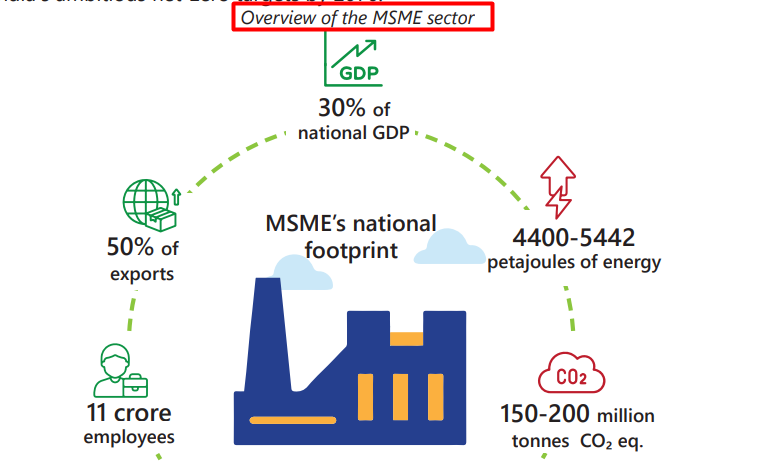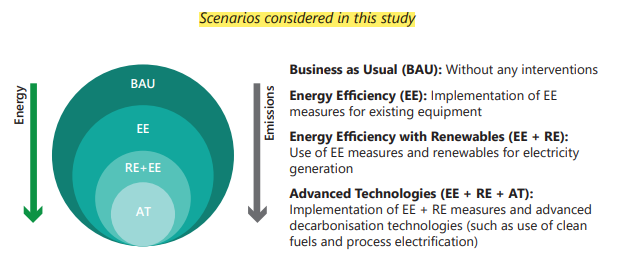Decarbonizing MSME and Energy Sector | 11 Jul 2024
Why in News?
Recently, a study on decarbonisation of 7 MSME clusters (Alathur, Asansol-Chirkunda, Bengaluru, Delhi-NCR, Coimbatore, Ludhiana and Tiruppur) has revealed that adopting renewable energy solutions and energy efficient measures could lead to significant annual savings and reduction in emissions of CO2.
- It covered sectors such as pharmaceuticals, refractories, aluminium die-casting, bakeries and textiles units across these clusters.
Note
- 'Decarbonisation' refers to the process of reducing 'carbon intensity', lowering the amount of greenhouse gas emissions produced by the burning of fossil fuels.
What are the Key Findings of the Study on MSMEs?
- Key Findings:
-
MSME Energy Consumption: Approximately 31% of MSMEs are in the manufacturing sector, contributing 20%-25% of the country's industrial energy use.
-
Over 80% of this energy is needed for thermal processes, such as heating in boilers and furnaces.
-
-
Initial Investment & Cost Saving: Adopting energy efficient measures, renewable energy solutions in 7 key MSME clusters would require investment of Rs 90 crore and this could annually lead to cost savings of Rs 37 crore.
-
Emission Reduction: Decarbonising these sectors would also lead to reduction of 1,36,581 tonnes of CO2 emissions.]
-
-
Recommendations:
- Improve Access to Finance: Offer affordable, collateral-free financing for MSMEs by reviewing loan eligibility, building capacity for financial institutions, and exploring carbon financing options.
- Tailor MSME Policies: Set emission reduction targets, support energy audits, R&D, pilots, and financing for energy efficiency and renewable energy.
- Develop Biofuel Ecosystem: Expand biomass policies, include biodiesel in government schemes, and facilitate bio-CNG sales.
- Increase Renewable Energy Use: Promote rooftop solar and open-access systems by rationalising charges, aggregating demand, and utilising cluster development schemes.
- Regulatory Incentives: Provide incentives for MSMEs to switch to cleaner fuels, simplify clean fuel adoption, and monitor Scope 3 emissions.
- Scope 3 Emission: Indirect emissions that are a consequence of the company’s activities (upstream and downstream of the manufacturing site).
Challenges in Decarbonising the Energy Sector in India
- Target and Current State: India aims to decarbonise its energy sector and increase the share of natural gas to over 20% by 2030.
- Natural gas currently comprises less than 6% of India’s energy mix, in contrast to over 35% in the US and 20% in China.
- Key Challenges in Expanding Natural Gas Infrastructure:
-
Regulatory Uncertainty and interventions: Government interventions in the natural gas sector, including price caps, limitations on LNG terminal expansion, and restrictions on city gas distribution networks, are creating uncertainty for investors and hindering the country's goal of expanding natural gas use.
-
Underutilisation of Existing LNG Import Capacity: Despite a 17% increase in LNG imports, the utilisation of India's 6 LNG import facilities was below 30% in FY 2023-24.
- Understaffing and Lack of Expertise at the Regulator (PNGRB): The Petroleum & Natural Gas Regulatory Board (PNGRB) has functioned with low staff and diminishing board strength in recent years which has led to delays in approvals and introduction of new gas market mechanisms.
- Transition from Coal to Gas: India's energy mix is still dominated by coal (over 50%) compared to natural gas (less than 6%) making the transitioning of a large energy system a challenging task.
-
Read more: Towards Decarbonising Transport 2023, Decarbonising Steel Sector
|
Drishti Mains Question: Discuss how decarbonization and energy transition can support the growth and development of the MSME sector in India. Analyse the challenges for MSMEs in adopting clean energy technologies and transitioning towards a low-carbon economy. |
UPSC Civil Services Examination, Previous Year Question (PYQ)
Q. Which one of the following statements best describes the term ‘Social Cost of Carbon’? It is a measure, in monetary value, of the (2020)
(a) long-term damage done by a tonne of CO2 emissions in a given year.
(b) requirement of fossil fuels for a country to provide goods and services to its citizens, based on the burning of those fuels.
(c) efforts put in by a climate refugee to adapt to live in a new place.
(d) contribution of an individual person to the carbon footprint on the planet Earth.
Ans: (a)
Q. Consider the following statements with reference to India : (2023)
- According to the Micro, Small and Medium Enterprises Development (MSMED) Act, 2006, the ‘medium enterprises’ are those with investments in plant and machinery between `15 crore and `25 crore.
- All bank loans to the Micro, Small and Medium Enterprises qualify under the priority sector.
Which of the statements given above is/are correct?
(a) 1 only
(b) 2 only
(c) Both 1 and 2
(d) Neither 1 nor 2
Ans: (b)
Q. Which of the following are some important pollutants released by steel industry in India? (2014)
- Oxides of sulphur
- Oxides of nitrogen
- Carbon monoxide
- Carbon dioxide
Select the correct answer using the code given below:
(a) 1, 3 and 4 only
(b) 2 and 3 only
(c) 1 and 4 only
(d) 1, 2, 3 and 4
Ans: (d)
Q. Steel slag can be the material for which of the following? (2020)
- Construction of base road
- Improvement of agricultural soil
- Production of cement
Select the correct answer using the code given below:
(a) 1 and 2 only
(b) 2 and 3 only
(c) 1 and 3 only
(d) 1, 2 and 3
Ans: (d)
Mains:
Q. Account for the present location of iron and steel industries away from the source of raw material, by giving examples. (2020)
Q. Account for the change in the spatial pattern of the Iron and Steel industry in the world. (2014)


